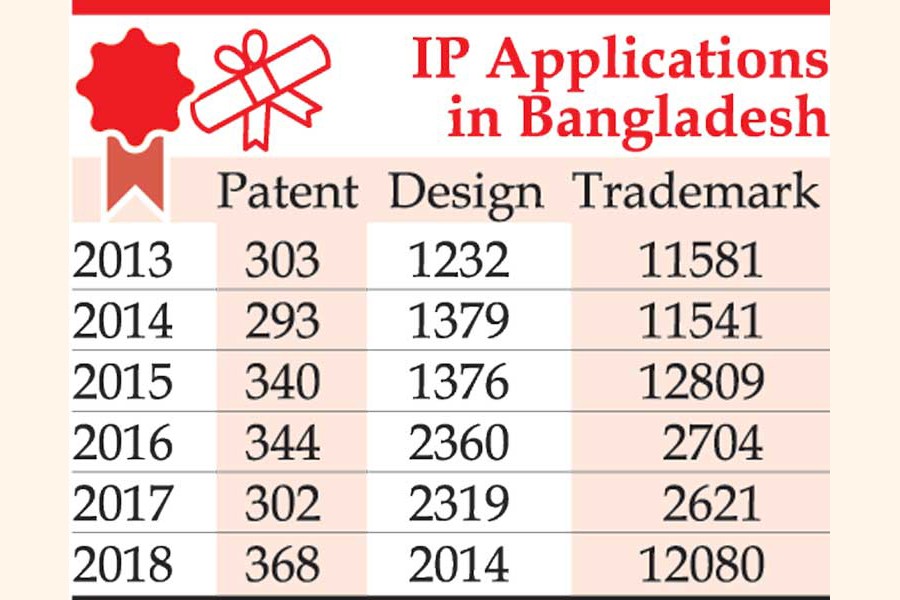
Why a strong intellectual property regime matters for Bangladesh
Muhammad Nazmul Khan | Sunday, 24 November 2019

 The idea of protecting claims to intellectual property (IP) – proprietary knowledge and inventions – is involved with almost as many tricky aspects as the inventions themselves. After all, how many of us haven't heard about the story of Sir Jagdish Chandra Bose and his claim to intellectual property in inventing the radio, even though the patenting of radio-wave based wireless telegraphy and consequent commercialisation of the technology was made by the Italian Guglielmo Marconi, who was the most successful amongst his researching peers in making money out of the thing!
The idea of protecting claims to intellectual property (IP) – proprietary knowledge and inventions – is involved with almost as many tricky aspects as the inventions themselves. After all, how many of us haven't heard about the story of Sir Jagdish Chandra Bose and his claim to intellectual property in inventing the radio, even though the patenting of radio-wave based wireless telegraphy and consequent commercialisation of the technology was made by the Italian Guglielmo Marconi, who was the most successful amongst his researching peers in making money out of the thing!
Very few would doubt that without the potential for commercial use, the radio apparatus would have remained a physicist's curiosity. This is what differentiates pure science from applied field. It is thus no surprise us that such research into the application of scientific knowledge for commercial use is conducted primarily not by specialists in the pure science, but by inventors and popularisers like Marconi and Edison. One can only wonder if they would have spared the effort had it led to no business opportunities, especially after receiving financing from others - family in case of Marconi, and JP Morgan in case of Edison. Nothing compares to piracy as a disincentive to innovation brought about by intellectual property. How does Bangladesh fare in protecting IP?
According to the Global Innovation Index (GII) 2019, published by the World Intellectual Property Organisation (WIPO), Bangladesh finds itself at the 108th position. This depressing statistic is underpinned by a lack of comprehensive national IP policy to coordinate the relevant laws and their enforcement, 34 years after joining the global body. The inefficiency of the court system, the dismal state of the education system in terms of creating a workforce with requisite skill sets, as well as an underdeveloped financial system-all play their part in keeping Bangladesh down as a hub for sustainable creative contribution, even with demographic dominated dividend.
When it comes to the state of enforcement regimes; there are two primary IP law-enforcement agencies of the government. The Department of Patents, Designs and Trade Marks (DPDT) under the Ministry of Industries (MOI) for industrial -level intellectual property matters (affiliated to with WIPO), and the Copyright Office under the Ministry of Cultural Affairs (MOCA) for all matters related to copyrights, especially of issues related to printing. The internal training and manpower development arrangements were deemed inadequate in a 2013 WIPO draft report on the necessity of an IP policy for Bangladesh, which is available on the web portal of DPDT.
Little, if anything, has changed since then. Meanwhile, its neighbouring countries are already making headways in the right direction. For example, the case of Sri Lanka. It established a National Intellectual Property Office (NIPO) back in 2003, even before India, which approved its own national IP rights policy only in 2016, but like Bangladesh it has yet to consolidate its enforcement regimes. Other South-east Asian economies like Singapore, Malaysia, Thailand and Vietnam are already years ahead in their innovativeness, as measured in their 2019 Global Innovation Index. The law enforcement mechanism is severely weak due to a lack of procedural rigor in executing justice such as lax follow-through of the case progression for sticking to stipulated timeline and specialised treatment of the matter separate from regular civil and criminal breaches of law. This was highlighted both by the GII 2019 and the 2013 report, meaning a lack of progress in the intervening six years.
Another important aspect is the status of higher education and human capital formation in a country; we can select as a test case the country of Malaysia. It ranks 35th in the world, 2nd amongst lower-middle income economies, and 8th out of all the South, South-east Asian, and Oceanian economies in the GII 2019. It scores high on market sophistication, knowledge output, and human capital development, which pushes its index higher, while Bangladesh finds itself in the lower rung at 127th place when it comes to developing its human capital. Malaysia even ranks first in the share of creative goods in its total export volume as well as in the share of high-tech goods in net export, making it the world leader in these categories.
The stellar record of Malaysia is driven by a lot of factors, the most important of which is its commitment to the quality of its higher education institutions, especially in the fields of science and technology. The proportion of graduates from these subjects in the overall graduating cohorts is an indicator of the infusion of skills into the job market that is necessary to sustain a satisfactory pace in industrialisation and new knowledge creation. Malaysia attracts students from almost all of South and South-east Asia due to its generous environment for research and knowledge output; Bangladeshi students are also the beneficiaries of this progress, with 28,000 of them studying there in 2017.
In terms of requisite skillsets in graduates, Bangladesh has had a bad run for almost entirety of its existence. The fractured primary and secondary education systems perpetuate the class structure of the society by pre-determining the prospect for social mobility of the students by either restricting or enhancing their participation in the tertiary education system. A student from a rural area who has not got a good English tutor in his first 12 years of schooling is in no way competitive when facing an English medium student from Dhaka who is sitting for an admission exam at IBA or for SAT. The same goes for the madrassah students who come from a specific socio-economic background, whose social mobility is generally restricted owing to an obsolete education system.
That does not stop more brilliant Bangladeshis from making progress in their own fields, but the countries that attract them as hosts with generous funding offers for graduate (masters and PhD) and postdoctoral research benefit from top most of their knowledge resources. Meanwhile, GDP remains dependent on sectors like apparels and trade, which are exposed to a lot of international political and economic risks and are on the verge of major structural changes like automation and shocks from feuds especially the current one between China and the USA.
In a world where the global economy is heading towards increasing adoption of automation to eliminate repetitive tasks which require less cognitive inputs and creative impulses, the abundance of local graduates in fields, which are not meant for mass employment, will be clear. This is especially true since a large part of the most promising cohort of students leave Bangladesh to study, whose numbers keep rising every year; the number of students who leave was 90 per day in 2017. At that time, a UNESCO Institute of Statistics report counted the number of students of Bangladeshi origin studying abroad to be 60,390. It is difficult to justify a counterfactual claim, it can't be confirmed how many of them would have chosen to go abroad regardless of their opportunities at home; but one can only wonder how many of them felt that their country's education system has failed them miserably, which in turn has made them leave. It probably isn't a small number.
Last, but not the least is the fragile financial system, which only recently has started becoming more friendly and comfortable towards financing idea-based ventures. Commercial banking in Bangladesh revolves around the financing of safe, collateral-secured financing of traditional manufacturing, and providing working capital to high cash-flow service and trading sector firms. Even there, a lot of hurdles remain, mainly due to a lack of risk management tools such a default swaps driven by price signaling mechanisms like secondary markets for securities like corporate bonds. These are all reflected in the ranking of Bangladesh at 122th in ease of getting credit by firms. Only recently did the establishment of venture capital and private equity-based financing industry has started to close the gap. But without the protection of strict enforcement, and requisite skillsets in graduates, only investors willing to finance good ideas are not going to make a difference.
Thus, Bangladesh urgently needs two very specific policies; firstly, it must create a national human resource development policy, aimed at capturing and harnessing the talent leaking out of the country. Secondly, it must develop a strong IP rights policy backed by a consolidated enforcement regime with specialised training and sufficient resources. The time is apparently limited. Bangladesh needs sincere leaders that are concerned about sustainable and long-term investment in developing an economy capable of integrating itself with a global economy heading into Industrial Revolution 4.0 characterised by Cognitive Capitalism.
The author is working as the Senior Treasury Executive at ACI Ltd. He can be reached at
[email protected]